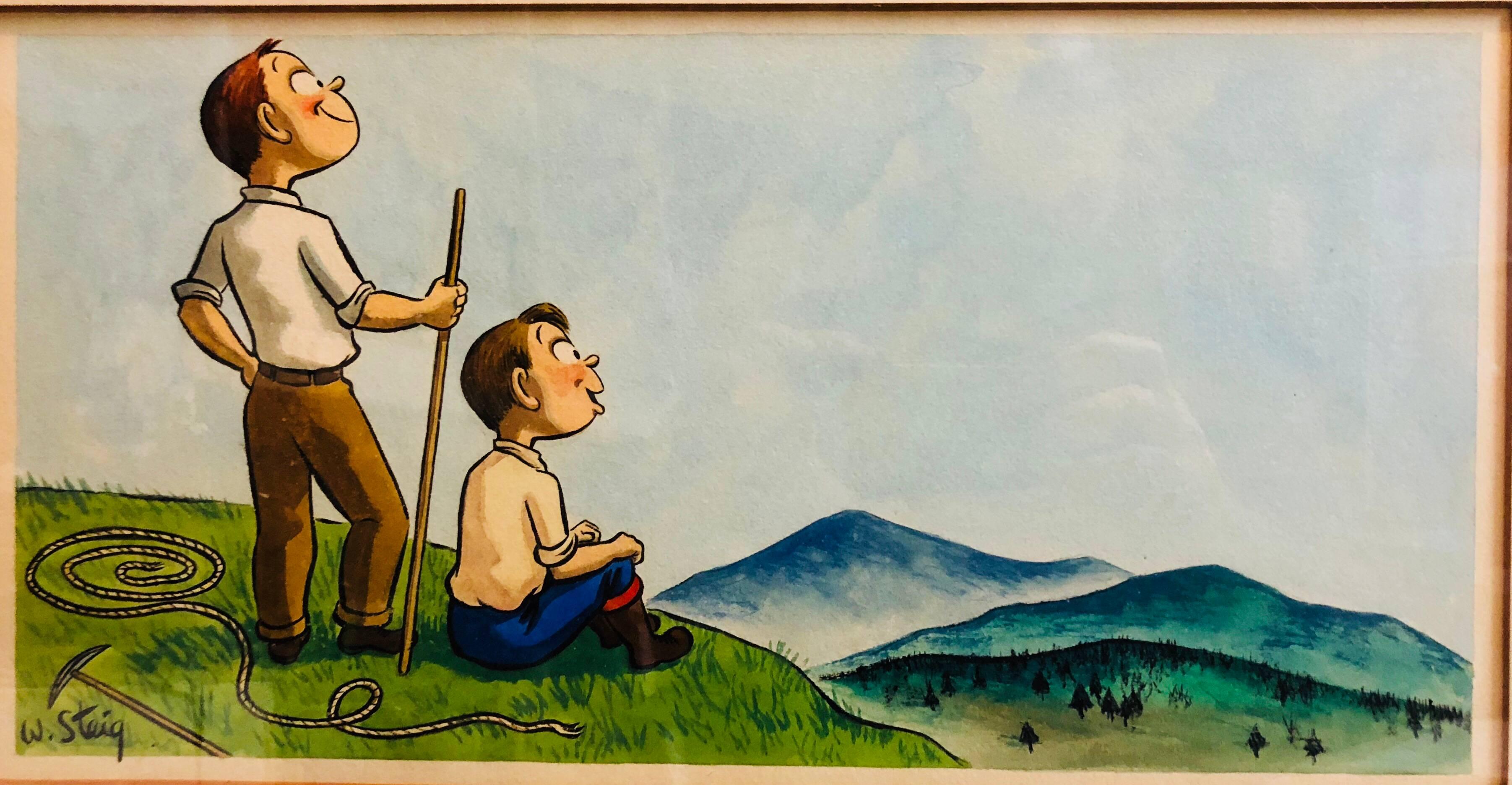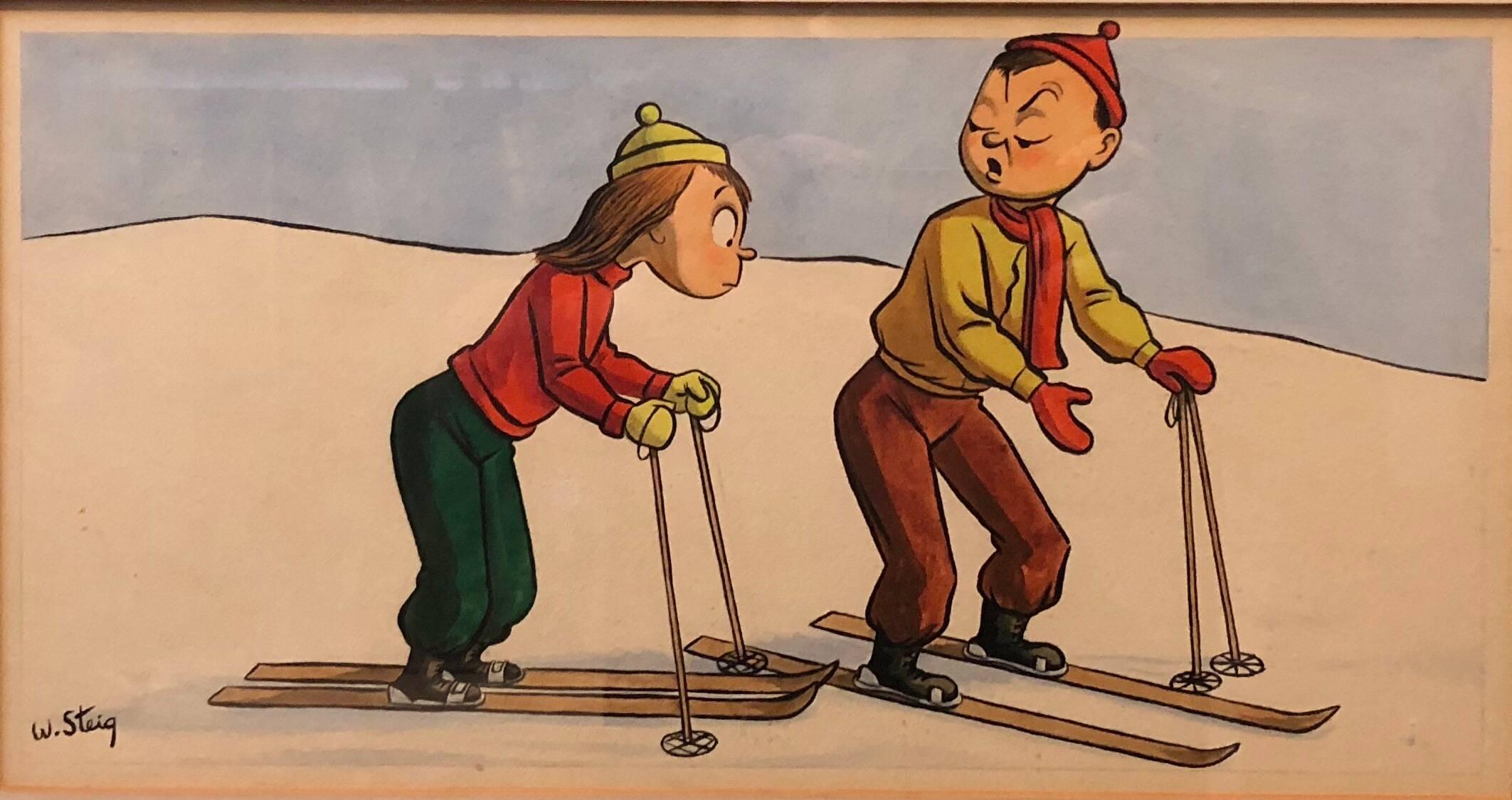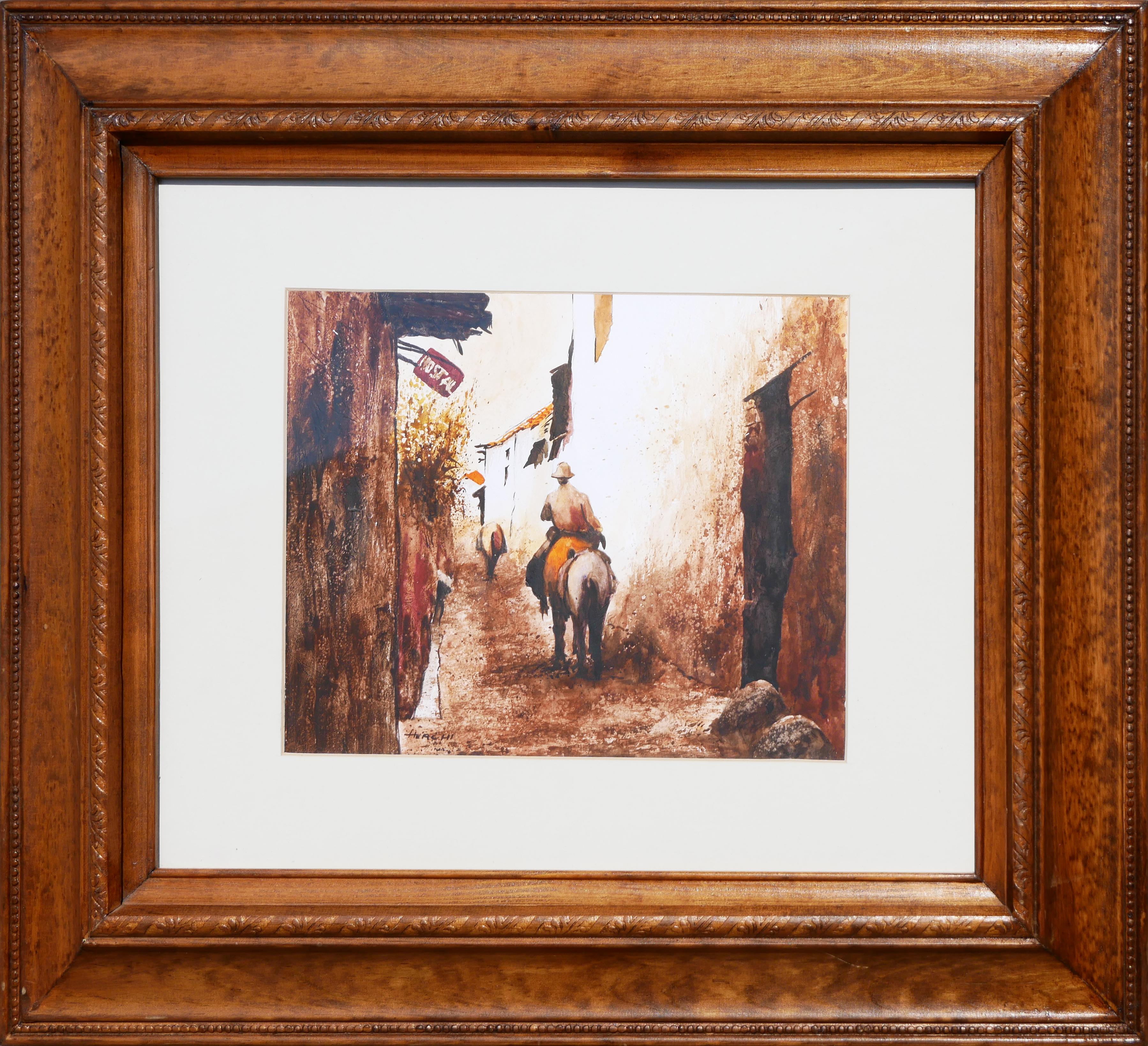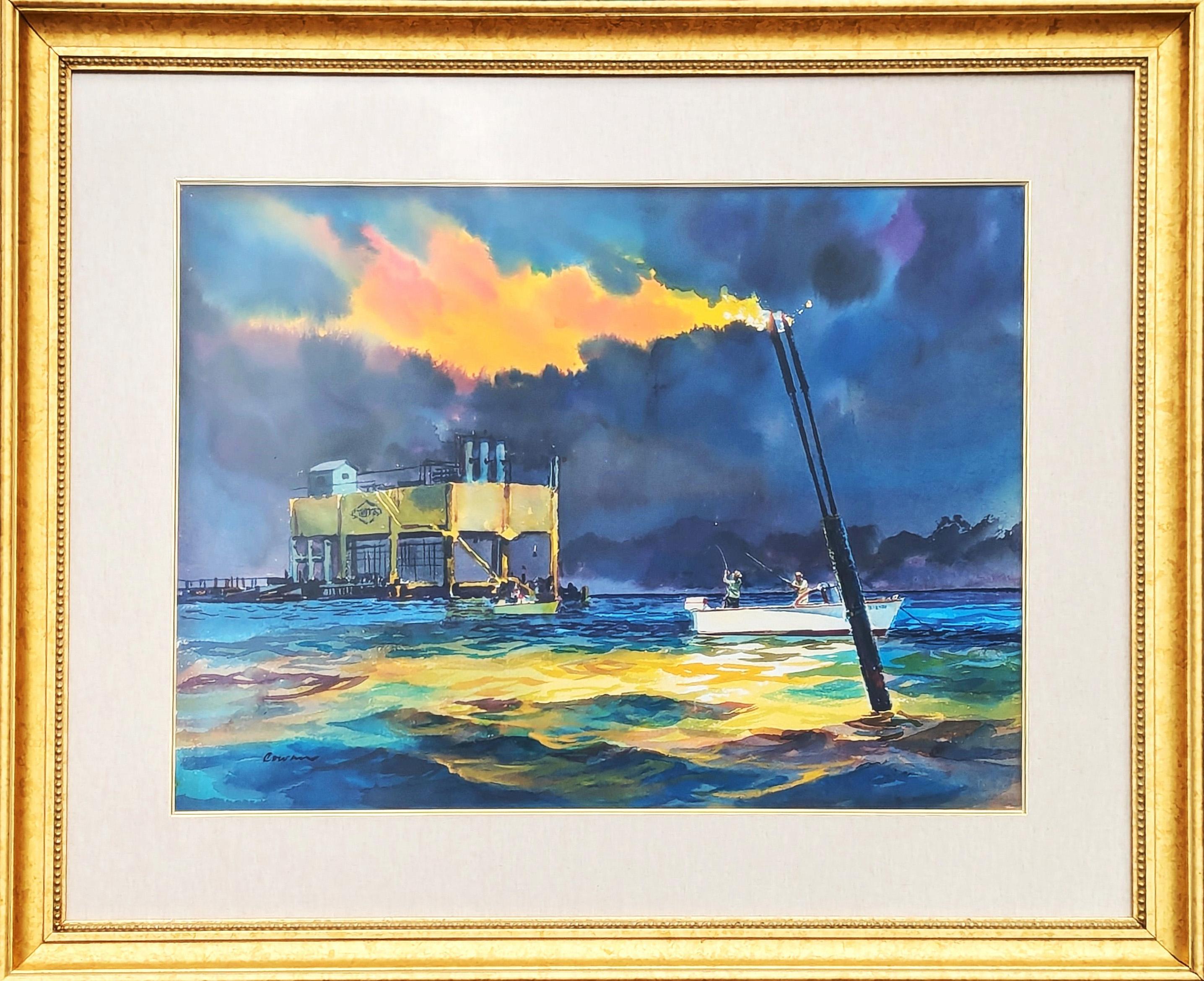Items Similar to America's Cup - 1967. Wing Mark, Intrepid and Dame Pattie.
Want more images or videos?
Request additional images or videos from the seller
1 of 12
Joseph Webster GolinkinAmerica's Cup - 1967. Wing Mark, Intrepid and Dame Pattie.1967.
1967.
About the Item
AMERICA'S CUP - 1967. WING MARK. INTREPID - DAME PATTIE [AUS].
This Joseph Webster Golinkin watercolor of the 1967 America's Cup depicts the US sailing yacht Intrepid and the Australian sailing yacht Dame Pattie at the Wing Mark. Signed upper left. Titled on verso. Painted on thick watercolor paper.
"With a light breeze on the surface and the promise of more aloft, Intrepid has completed her jibe around the yard tug at the wing mark. Her bow-man at the shrouds calls trim as she sharpens on new reach. Dame Pattie's spinnaker softens as she runs off toward jibe at mark...." The Intrepid won the 1967 America’s Cup race. This watercolor was used as an illustration in "The Twelve Meter Challenges for the America's Cup" - Norris D. Hoyt.
The American sailing yacht INTREPID was designed by Olin Stephens and Britton Chance, Jr. (re-design). Intrepid won two America’s Cup races- 1967 and 1970. The Australian yacht DAME PATTIE was designed by Warwick Hood and built by W. H. Barnett.
JOSEPH WEBSTER GOLINKIN
(1896-1977)
Painter, printmaker, naval officer, politician, environmentalist, and philanthropist. He was a true renaissance man – excelling in everything he pursued.
Golinkin was born in Chicago on September 10, 1896, and studied at the Art Institute of Chicago. He entered the United States Naval Academy and upon graduation was commissioned as an Ensign and immediately deployed to serve in World War I. He remained in the Navy until 1922 when he resigned from his commission to pursue his original career as an artist. He remained, however, in the active reserve as a Lieutenant Commander.
After leaving the Navy, Golinkin moved to New York where he studied at the Art Students League with Ash Can school artist, George Luks. The two artists became fast friends and Luks introduced him to many other artists. During the 1920s and 1930s, Golinkin exhibited with other well-known artists including George Bellows, Joseph Margulies, and David Shotwell. He was also represented by well-known dealers in New York City including Ferargil Galleries, Macbeth Gallery, and Van der Straeten. He had one-artist shows at the Museum of the City of New York, Macbeth Gallery, Ferargil Galleries, Gump's in San Francisco, San Francisco Art Gallery, and the Los Angeles Olympics in 1984. His works are part of many museum collections including the Metropolitan Museum, New York Public Library, Museum of the City of New York, Library of Congress, and the Art Institute of Chicago.
As an artist, Golinkin worked in many mediums including painting, watercolor, and lithography. While his subjects varied, two would dominate his work – scenes of New York and sports. He produced a large body of prints, drawings, and lithographs surrounding these two subjects. His images of New York cover many subjects including scenes of life in the city and the buildings. The images capture the ambiance of the late 1920s and early 1930s.
The sporting events Golinkin depicted include baseball, bicycle racing, bowling, boxing, football, hockey, horse racing, horse shows, golf, polo, tennis, track and field, wrestling, and yacht racing. He was awarded the Gold Medal for Artistic Excellence in Relation to Sport at the X Olympiad in 1932 and again at the XI Olympiad in 1936. Golinkin's sporting scenes have been reproduced as posters for several Olympic Games. His work is also in the collections of the Baseball Hall of Fame, the Palm Beach Polo Club, Madison Square Garden, numerous yacht clubs, and in the personal collections of well-known athletes and sports enthusiasts throughout the world.
When the Navy reactivated him in 1938, his artistic career was put on hold. He served with great distinction during WWII, was awarded the Bronze Star, and retired from the Navy in 1958 with the rank of Rear Admiral. His other careers include serving for twelve years as Mayor of Centre Island, New York. As an early environmentalist, he formed a nonpartisan civic association that successfully opposed building a Robert Moses proposed bridge that would have connected Oyster Bay and Rye, New York. Golinkin not only served his country as an officer in the Navy, a politician, and civic leader, but he also left a large legacy of his artistic vision of the city and sporting life in America.
- Creator:Joseph Webster Golinkin (1896 - 1977)
- Creation Year:1967.
- Dimensions:Height: 22.25 in (56.52 cm)Width: 30.38 in (77.17 cm)Depth: 0.98 in (2.49 cm)
- Medium:
- Movement & Style:
- Period:
- Framing:Framing Options Available
- Condition:The watercolor paper was, at the time of painting, gently stretched and tacked to a stretcher. There is a 3/8 inch paper margin with tack hole stains around the painting - this can easily be matted out when framing or reattached to a stretcher.
- Gallery Location:New York, NY
- Reference Number:
About the Seller
4.6
Recognized Seller
These prestigious sellers are industry leaders and represent the highest echelon for item quality and design.
Established in 1898
1stDibs seller since 2015
50 sales on 1stDibs
Typical response time: 1 to 2 days
Associations
International Fine Print Dealers Association
- ShippingRetrieving quote...Ships From: New York, NY
- Return PolicyA return for this item may be initiated within 14 days of delivery.
More From This SellerView All
- The Lumber WharfBy Gordon GrantLocated in New York, NYGordon Hope Grant (1875-1962) created the watercolor entitled “The Lumber Wharf” in circa 1947. It is signed in the lower left 1 inch above the paper edge. The watercolor paper size ...Category
1940s Naturalistic Landscape Drawings and Watercolors
MaterialsWatercolor
- Schooner St. CroixBy Emilio SanchezLocated in New York, NYEmilio Sanchez (1921-1999) created the watercolor entitled “Schooner St. Croix” in 1952. This piece is signed in pen at the lower right and titled on the verso. The paper size is 16.88 x 22.25 inches. Stamped on verso "Estate of Emilio Sanchez." Good to very good condition. “Best known for his architectural paintings and lithographs, Emilio Sanchez (1921-1999) explored the effects of light and shadow to emphasize the abstract geometry of his subjects. His artwork encompasses his Cuban heritage...Category
1950s American Realist Landscape Drawings and Watercolors
MaterialsGraphite, Watercolor
- [untitled] Street Scene with Fruit Vendor.By Emilio SanchezLocated in New York, NYEmilio Sanchez (1921-1999) created [untitled] “STREET SCENE WITH FRUIT VENDOR” in circa 1950. This unsigned watercolor and came to us directly from the Sanchez estate. It is stamped on the verso "Estate of Emilio Sanchez." This piece is in good to very good condition and painted to the paper's edge. The paper size is 14.88 x 15.25 inches (37.6 x 38.6 cm). “Best known for his architectural paintings and lithographs, Emilio Sanchez (1921-1999) explored the effects of light and shadow to emphasize the abstract geometry of his subjects. His artwork encompasses his Cuban heritage...Category
1950s American Modern Figurative Drawings and Watercolors
MaterialsGraphite, Watercolor
- Colon [Panama]By Reynolds BealLocated in New York, NYReynolds Beal painted this watercolor entitled “Colon” [Panama] in the spring of 1923. The paper size of this painting is 7 x 10" (17.7 x 25.3 cm). It is signed, titled, and dated ...Category
Early 20th Century American Impressionist Landscape Drawings and Waterco...
MaterialsPencil, Watercolor
- AMERICA'S CUP - 1967. BEAT TO THE FINISH - INTREPID (USA) VS. DAME PATTIE (AUS)By Joseph Webster GolinkinLocated in New York, NYAMERICA'S CUP - 1967. BEAT TO THE FINISH - INTREPID (USA) VS. DAME PATTIE (AUS). “Beat to the Finish” is a 1967 watercolor by Joseph Webster ...Category
1960s Naturalistic Landscape Drawings and Watercolors
MaterialsWatercolor
- Plan of a Part of Newport, R. I. Showing Changes... O. H. P, Belmont, Esq.Located in New York, NYPLAN OF A PART OF NEWPORT, R.I. SHOWING CHANGES IN HIGHWAYS ASKED FOR BY O.H.P. BELMONT, ESQ. The original ink and watercolor plan on paper from 1907. The plan is extremely large; if fully assembled it would measure no less than 11.5 feet in height and 6.5 feet in breadth. Segmented and backed on modern linen in four sections – each section is 70 x 39 inches. This grand oversized folding map can be folded down to four sections each 17.5 x 11 inches and stored in a modern made leather and marble paper case 18 x 11.75 x 3 inches. Text continues, "Prepared for Charles Warren Lippitt at the office of J. P. Cotton, C.E. Newport, R.I. Oct. 28, 1907." A fine manuscript plan of the Bellevue neighborhood of Newport, depicting the street layout and the detailed footprints of the area’s many mansions. The plan was produced at the behest of Charles Warren Lippett (1846-1924), who served as governor of Rhode Island from 1895-1897. The Lippett “Breakwater” mansion is also shown on this plan, situated at the southernmost tip of the peninsula. Though the circumstances are unclear, Lippitt seems to have requested the plan be drawn out of some concern for road construction proposed by Oliver Hazard Perry...Category
Early 20th Century Naturalistic More Art
MaterialsInk, Watercolor
You May Also Like
- Gustav Melcher ( German, 1898 -?) Boats off Venice Italy Ink Water Color c. 1918By Gustav MelcherLocated in Meinisberg, CHGustav Melcher (German, 1898-?) Segelschiffe vor Venedig - Sailing ships off Venice • India ink, water colour wash • Visible image ca. 11.5 x 18 cm • Glased Frame ca. 20 x 25 cm • Verso various inscriptions • Signed lower right Gustav Melcher was a German painter and a pioneer in film, film criticism and film theory and created this clever little picture of the skyline of Venice with various vessels. Going by the various inscriptions an the backing paper, this drawing was made in 1918 when Gustav was twenty years old and passed on three years later to Gertrud Melcher on the 1. 2. 1921. I have no reasons to doubt this information. The small drawing is still in its unopened frame, so maybe there is more information to be discovered , however this will be the privilege of the next owner. The picture also has retained its original antique frame – note that it has lost over the years various sections of the gesso decoration. The very precisely executed drawing is most enjoyable to look at and doing so, remember you are looking through the eyes of a young man, who saw this foreign sea cape over a century ago. Thank you for your interest and please note, that I offer free worldwide shipping on all my items. Gustav Melcher began his studies at the Düsseldorfer Kunstakademie under Peter Janssen and Eduard von Gebhardt. Originaly he was interested in figurative and portrait painting, but after time he decided to pursue the depiction of land- and marinescapes. Durin his studies the young artist undertook trips to visit England, Scotland, Belgium and France and he joined the artist society Malkasten. It was in those days he would hold speeches to his colleges about this new invention called ‘Kintopp’ – Melcher was a great advocate of the moving pictures...Category
1910s Naturalistic Landscape Drawings and Watercolors
MaterialsIndia Ink, Paper, Watercolor
- Whimsical Illustration Hiking Cartoon, 1938 Mt Tremblant Ski Lodge William SteigBy William Steig (b.1907)Located in Surfside, FLLighthearted Illustration of Outdoor Pursuits This one being cross country hiking signed "W. Steig" Provenance: from Mrs. Joseph B. Ryan, Commissioned by Joe Ryan for the bar at his ski resort, Mount Tremblant Lodge, in 1938. Mont Tremblant, P.Q., Canada Watercolor and ink on illustration board, sights sizes 8 1/2 x 16 1/2 in., framed. In 1938 Joe Ryan, described as a millionaire from Philadelphia, bushwhacked his way to the summit of Mont Tremblant and was inspired to create a world class ski resort at the site. In 1939 he opened the Mont Tremblant Lodge, which remains part of the Pedestrian Village today. This original illustration is on Whatman Illustration board. the board measures 14 X 22 inches. label from McClees Galleries, Philadelphia, on the frame backing paper. William Steig, 1907 – 2003 was an American cartoonist, sculptor, and, in his later life, an illustrator and writer of children's books. Best known for the picture books Sylvester and the Magic Pebble, Abel's Island, and Doctor De Soto, he was also the creator of Shrek!, which inspired the film series of the same name. He was the U.S. nominee for both of the biennial, international Hans Christian Andersen Awards, as a children's book illustrator in 1982 and a writer in 1988. Steig was born in Brooklyn, New York in 1907, and grew up in the Bronx. His parents were Polish-Jewish immigrants from Austria, both socialists. His father, Joseph Steig, was a house painter, and his mother, Laura Ebel Steig, was a seamstress who encouraged his artistic leanings. As a child, he dabbled in painting and was an avid reader of literature. Among other works, he was said to have been especially fascinated by Pinocchio.He graduated from Townsend Harris High School at 15 but never completed college, though he attended three, spending two years at City College of New York, three years at the National Academy of Design and a mere five days at the Yale School of Fine Arts before dropping out of each. Hailed as the "King of Cartoons" Steig began drawing illustrations and cartoons for The New Yorker in 1930, producing more than 2,600 drawings and 117 covers for the magazine. Steig, later, when he was 61, began writing children's books. In 1968, he wrote his first children's book. He excelled here as well, and his third book, Sylvester and the Magic Pebble (1969), won the Caldecott Medal. He went on to write more than 30 children's books, including the Doctor DeSoto series, and he continued to write into his nineties. Among his other well-known works, the picture book Shrek! (1990) formed the basis for the DreamWorks Animation film Shrek (2001). After the release of Shrek 2 in 2004, Steig became the first sole-creator of an animated movie franchise that went on to generate over $1 billion from theatrical and ancillary markets after only one sequel. Along with Maurice Sendak, Saul Steinberg, Ludwig Bemelmans and Laurent de Brunhofff his is one of those rare cartoonist whose works form part of our collective cultural heritage. In 1984, Steig's film adaptation of Doctor DeSoto directed by Michael Sporn was nominated for the Academy Award for Best Animated Short Film. As one of the most admired cartoonists of all time, Steig spent seven decades drawing for the New Yorker magazine. He touched generations of readers with his tongue–in–cheek pen–and–ink drawings, which often expressed states of mind like shame, embarrassment or anger. Later in life, Steig turned to children's books, working as both a writer and illustrator. Steig's children's books were also wildly popular because of the crazy, complicated language he used—words like lunatic, palsied, sequestration, and cleave. Kids love the sound of those words even if they do not quite understand the meaning. Steig's descriptions were also clever. He once described a beached whale as "breaded with sand." Throughout the course of his career, Steig compiled his cartoons and drawings into books. Some of them were published first in the New Yorker. Others were deemed too dark to be printed there. Most of these collections centered on the cold, dark psychoanalytical truth about relationships. They featured husbands and wives fighting and parents snapping at their kids. His first adult book, Man About Town, was published in 1932, followed by About People, published in 1939, which focused on social outsiders. Sick of Each Other, published in 2000, included a drawing depicting a wife holding her husband at gunpoint, saying, "Say you adore me." According to the Los Angeles Times, fellow New Yorker artist Edward Sorel...Category
1930s Naturalistic Figurative Drawings and Watercolors
MaterialsArchival Ink, Watercolor, Illustration Board
- Whimsical Illustration Skiing Cartoon, 1938 Mt Tremblant Ski Lodge William SteigBy William Steig (b.1907)Located in Surfside, FLLighthearted Illustration of Outdoor Pursuits This one being a Skiing scene, a boy and a girl on skis. signed W. Steig Provenance: from Mrs. Joseph B. Ryan, Commissioned by Joe Ryan for the bar at his ski resort, Mount Tremblant Lodge, in 1938. Mont Tremblant, P.Q., Canada Watercolor and ink on illustration board, sights sizes 8 1/2 x 16 1/2 in., framed. In 1938 Joe Ryan, described as a millionaire from Philadelphia, bushwhacked his way to the summit of Mont Tremblant and was inspired to create a world class ski resort at the site. In 1939 he opened the Mont Tremblant Lodge, which remains part of the Pedestrian Village today. This original illustration is on Whatman Illustration board. the board measures 14 X 22 inches. label from McClees Galleries, Philadelphia, on the frame backing paper. William Steig, 1907 – 2003 was an American cartoonist, sculptor, and, in his later life, an illustrator and writer of children's books. Best known for the picture books Sylvester and the Magic Pebble, Abel's Island, and Doctor De Soto, he was also the creator of Shrek!, which inspired the film series of the same name. He was the U.S. nominee for both of the biennial, international Hans Christian Andersen Awards, as a children's book illustrator in 1982 and a writer in 1988. Steig was born in Brooklyn, New York in 1907, and grew up in the Bronx. His parents were Polish-Jewish immigrants from Austria, both socialists. His father, Joseph Steig, was a house painter, and his mother, Laura Ebel Steig, was a seamstress who encouraged his artistic leanings. As a child, he dabbled in painting and was an avid reader of literature. Among other works, he was said to have been especially fascinated by Pinocchio.He graduated from Townsend Harris High School at 15 but never completed college, though he attended three, spending two years at City College of New York, three years at the National Academy of Design and a mere five days at the Yale School of Fine Arts before dropping out of each. Hailed as the "King of Cartoons" Steig began drawing illustrations and cartoons for The New Yorker in 1930, producing more than 2,600 drawings and 117 covers for the magazine. Steig, later, when he was 61, began writing children's books. In 1968, he wrote his first children's book. He excelled here as well, and his third book, Sylvester and the Magic Pebble (1969), won the Caldecott Medal. He went on to write more than 30 children's books, including the Doctor DeSoto series, and he continued to write into his nineties. Among his other well-known works, the picture book Shrek! (1990) formed the basis for the DreamWorks Animation film Shrek (2001). After the release of Shrek 2 in 2004, Steig became the first sole-creator of an animated movie franchise that went on to generate over $1 billion from theatrical and ancillary markets after only one sequel. Along with Maurice Sendak, Saul Steinberg, Ludwig Bemelmans and Laurent de Brunhofff his is one of those rare cartoonist whose works form part of our collective cultural heritage. In 1984, Steig's film adaptation of Doctor DeSoto directed by Michael Sporn was nominated for the Academy Award for Best Animated Short Film. As one of the most admired cartoonists of all time, Steig spent seven decades drawing for the New Yorker magazine. He touched generations of readers with his tongue–in–cheek pen–and–ink drawings, which often expressed states of mind like shame, embarrassment or anger. Later in life, Steig turned to children's books, working as both a writer and illustrator. Steig's children's books were also wildly popular because of the crazy, complicated language he used—words like lunatic, palsied, sequestration, and cleave. Kids love the sound of those words even if they do not quite understand the meaning. Steig's descriptions were also clever. He once described a beached whale as "breaded with sand." Throughout the course of his career, Steig compiled his cartoons and drawings into books. Some of them were published first in the New Yorker. Others were deemed too dark to be printed there. Most of these collections centered on the cold, dark psychoanalytical truth about relationships. They featured husbands and wives fighting and parents snapping at their kids. His first adult book, Man About Town, was published in 1932, followed by About People, published in 1939, which focused on social outsiders. Sick of Each Other, published in 2000, included a drawing depicting a wife holding her husband at gunpoint, saying, "Say you adore me." According to the Los Angeles Times, fellow New Yorker artist Edward Sorel...Category
1930s Naturalistic Figurative Drawings and Watercolors
MaterialsArchival Ink, Watercolor, Illustration Board
- Brown-Toned Naturalistic Backstreet City Scene Watercolor LandscapeLocated in Houston, TXNeutral tone naturalistic city scene by an unknown artist. The work features a central figure on horseback riding down a village backstreet. The "hostal" street sign overhead indicat...Category
20th Century Naturalistic Figurative Drawings and Watercolors
MaterialsWatercolor
- "Trinity Flares" Modern Blue Toned Fishing Landscape Watercolor PaintingLocated in Houston, TXModern watercolor seascape painting by renowned sporting artists John P. Cowan. The work was originally created by Cowan to be used by Schlumberger as part of their fishing schedule calendar. Signed in the front lower left corner. Currently hung in a gold frame with a cream matting. Provenance includes a framed letter...Category
1960s Naturalistic Landscape Drawings and Watercolors
MaterialsWatercolor
- Niagra Falls Spring and Winter Watercolor LandscapesBy Maude LeachLocated in Houston, TXOriginal watercolor landscape painting of Niagra falls in the winter and in the spring. The pair of paintings are signed by the artist in the bottom corne...Category
20th Century Naturalistic Landscape Drawings and Watercolors
MaterialsWatercolor





